Publications/ Presentations
Filter by type:

Surface texture modulation via buckling in porous inclined mechanical metamaterials
doi:10.1016/j.eml.2021.101549
Abstract
Porous materials with well-defined periodicity are commonly encountered in biological and synthetic structures and exhibit a wide range of behaviors, ranging from negative Poisson’s ratios, to high energy absorption and acoustic damping. Recently, the response of these systems has been shown to be enhanced by mechanical instabilities that lead to sudden and reversible geometric transformations. Although buckling induces planar transformations in most of 2D porous metematerials, here we describe the emergence of 3D morphologies triggered by mechanical instabilities in an elastomeric block with tilted cylindrical holes. As a proof of concept, we demonstrate that these structures can be leveraged to tune surface properties including friction and light reflection, thus providing a new experimental platform for investigating deformation-dependent dynamics for tribological and optical applications.
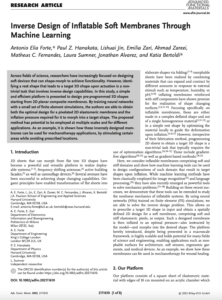
Inverse design of inflatable soft membranes through machine learning
doi:10.1002/adfm.202111610
Abstract
Across fields of science, researchers have increasingly focused on designing soft devices that can shape-morph to achieve functionality. However, identifying a rest shape that leads to a target 3D shape upon actuation is a non-trivial task that involves inverse design capabilities. In this study we present a simple and efficient platform to design pre-programmed 3D shapes starting from two-dimensional planar composite membranes. By training Neural Networks with a small set of finite element simulations, we were able to obtain both the optimal design for a pixelated 2D elastomeric membrane and the inflation pressure required for it to morph into a target shape. The proposed method has potential to be employed at multiple scales and for different applications. As an example, we show how these inversely designed membranes can be used for mechanotherapy applications, by stimulating certain areas whilst avoiding prescribed locations.
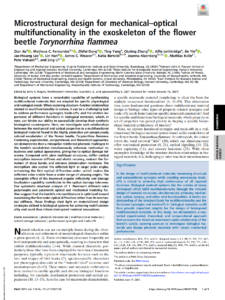
Microstructural design for mechanical–optical multifunctionality in the exoskeleton of the flower beetle Torynorrhina flammea
doi:10.1073/pnas.2101017118
Abstract
Biological systems have a remarkable capability of synthesizing multifunctional materials that are adapted for specific physiological and ecological needs. When exploring structure–function relationships related to multifunctionality in nature, it can be a challenging task to address performance synergies, trade-offs, and the relative importance of different functions in biological materials, which, in turn, can hinder our ability to successfully develop their synthetic bioinspired counterparts. Here, we investigate such relationships between the mechanical and optical properties in a multifunctional biological material found in the highly protective yet conspicuously colored exoskeleton of the flower beetle, Torynorrhina flammea. Combining experimental, computational, and theoretical approaches, we demonstrate that a micropillar-reinforced photonic multilayer in the beetle’s exoskeleton simultaneously enhances mechanical robustness and optical appearance, giving rise to optical damage tolerance. Compared with plain multilayer structures, stiffer vertical micropillars increase stiffness and elastic recovery, restrain the formation of shear bands, and enhance delamination resistance. The micropillars also scatter the reflected light at larger polar angles, enhancing the first optical diffraction order, which makes the reflected color visible from a wider range of viewing angles. The synergistic effect of the improved angular reflectivity and damage localization capability contributes to the optical damage tolerance. Our systematic structural analysis of T. flammea’s different color polymorphs and parametric optical and mechanical modeling further suggest that the beetle’s microarchitecture is optimized toward maximizing the first-order optical diffraction rather than its mechanical stiffness. These findings shed light on material-level design strategies utilized in biological systems for achieving multifunctionality and could thus inform bioinspired material innovations.
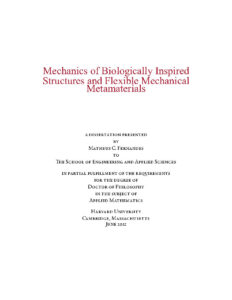
Mechanics of Biologically Inspired Structures and Flexible Mechanical Metamaterials
Abstract
In this dissertation, I focus on exploring biologically inspired structures and the mechanics of flexible porous metamaterials by utilizing both experimental and computational methods. For the biologically inspired structures portion of this dissertation, namely chapters 2 and 3, I focus on the architectural details of the glassy skeletal system from the hexactinellid sponge, Euplectella aspergillum. In chapter 2, I show that this sponge’s meso-scale skeletal system, consisting of a square-grid-like lattice architecture overlaid with a double set of crossed diagonal bracings, exhibits the highest buckling resistance for a given amount of material when compared to related lattice structures. These findings are further confirmed thorough an evolutionary optimization algorithm, through which I demonstrate that the sponge-inspired lattice geometry occurs near the design space’s optimum material distribution. At another level of structural hierarchy, in chapter 3 I show that its complex maze-like organization of helical ridges that surround its main skeletal tube, not only provide additional mechanical reinforcement, but perhaps more significantly, deliver a critical hydrodynamic benefit by effectively suppressing von Kármán vortex shedding and reducing fluctuations in lift forcing over a wide range of biologically relevant flow regimes. By comparing the disordered sponge ridge geometry to other more symmetrical strake-based vortex suppression systems commonly employed in engineering contexts ranging from antennas to underwater gas and oil pipelines, I find that the unique maze-like ridge organization of the sponge can completely suppress vortex shedding rather than delaying the shedding to a more downstream location. These findings highlight the sponge ridge design’s potential benefit in engineering applications. Lastly, in chapter 4, I utilize similar experimental and computational methods to study the response of porous mechanical metamaterials with well-defined periodicity for their ability to exhibit complex behavior as a result of their non-linear deformation. Although it is well known that buckling-induced planar transformations occur in 2D porous metamaterials, here I explore the emergence of 3D morphologies triggered by mechanical instabilities in an elastomeric block with tilted cylindrical holes. I demonstrate that the 3D deformation of these structures can be leveraged to tune surface properties including friction and light reflection, thus providing a new experimental platform for investigating deformation-dependent dynamics for tribological and optical applications.
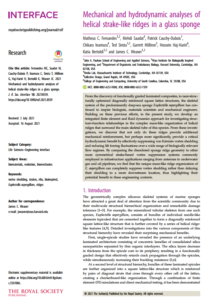
Mechanical and hydrodynamic analyses of helical strake-like ridges in a glass sponge
doi:10.1098/rsif.2021.0559
Abstract
From the discovery of functionally graded laminated composites, to near-structurally optimized diagonally reinforced square lattice structures, the skeletal system of the predominantly deep-sea sponge Euplectella aspergillum has continued to inspire biologists, materials scientists and mechanical engineers. Building on these previous efforts, in the present study, we develop an integrated finite element and fluid dynamics approach for investigating structure–function relationships in the complex maze-like organization of helical ridges that surround the main skeletal tube of this species. From these investigations, we discover that not only do these ridges provide additional mechanical reinforcement, but perhaps more significantly, provide a critical hydrodynamic benefit by effectively suppressing von Kármán vortex shedding and reducing lift forcing fluctuations over a wide range of biologically relevant flow regimes. By comparing the disordered sponge ridge geometry to other more symmetrical strake-based vortex suppression systems commonly employed in infrastructure applications ranging from antennas to underwater gas and oil pipelines, we find that the unique maze-like ridge organization of E. aspergillum can completely suppress vortex shedding rather than delaying their shedding to a more downstream location, thus highlighting their potential benefit in these engineering contexts.
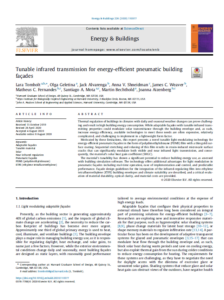
Tunable infrared transmission for energy efficient pneumatic building façades
doi:10.1016/j.enbuild.2020.110377
Abstract
Thermal regulation of buildings in climates with daily and seasonal weather changes can prove challenging and result in high building energy consumption. While adaptable façades with tunable infrared transmitting properties could modulate solar transmittance through the building envelope and, as such, increase energy efficiency, available technologies to meet these needs are often expensive, relatively complicated, and challenging to implement in a lightweight form factor.
Motivated by these limitations, this report presents a novel tunable light-modulating technology for energy-efficient pneumatic façades in the form of polydimethylsiloxane (PDMS) film with a thin gold surface coating. Sequential stretching and relaxing of this film results in strain-induced microscale surface cracks that can significantly modulate both visible and near infrared light transmission, and consequently, the material’s solar heat gain coefficient (SHGC).
The material’s tunability has shown a significant potential to reduce building energy use, as assessed with building simulation software. The technology offers additional advantages for light modulation in pneumatic façades including real-time operation, ease of implementation and control, and predictable performance. Façade design guidelines for the integration of the infrared-regulating film into ethylene tetrafluoroethylene (ETFE) building envelopes and climate suitability are described, and a critical evaluation of material durability, optical clarity, and material costs are provided.
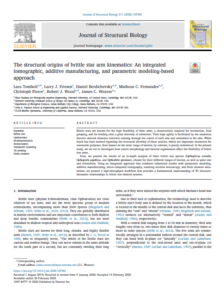
The structural origins of brittle star arm kinematics: An integrated tomographic, additive manufacturing, and parametric modeling-based approach
doi:10.1016/j.jsb.2020.107481
Abstract
Brittle stars are known for the high flexibility of their arms, a characteristic required for locomotion, food grasping, and for holding onto a great diversity of substrates. Their high agility is facilitated by the numerous discrete skeletal elements (ossicles) running through the center of each arm and embedded in the skin. While much has been learned regarding the structural diversity of these ossicles, which are important characters for taxonomic purposes, their impact on the arms’ range of motion, by contrast, is poorly understood. In the present study, we set out to investigate how ossicle morphology and skeletal organization affect the flexibility of brittle star arms. Here, we present the results of an in-depth analysis of three brittle star species (Ophioplocus esmarki, Ophiopteris papillosa, and Ophiothrix spiculata), chosen for their different ranges of motion, as well as spine size and orientation. Using an integrated approach that combines behavioral studies with parametric modeling, additive manufacturing, micro-computed tomography, scanning electron microscopy, and finite element simulations, we present a high-throughput workflow that provides a fundamental understanding of 3D structurekinematic relationships in brittle star skeletal systems.

Mechanically Robust Lattices Inspired By Deep-Sea Glass Sponges
doi:10.1038/s41563-020-0798-1
Abstract
The predominantly deep-sea hexactinellid sponges are known for their ability to construct remarkably complex skeletons from amorphous hydrated silica. The skeletal system from one such example, Euplectella aspergillum, consists of a square-grid-like architecture overlaid with a double set of diagonal bracings, creating a checkerboard-like pattern of open and closed cells. Here, using a combination of finite element simulations and mechanical tests on 3D-printed specimens of different lattice geometries, we show that the sponge's diagonal reinforcement strategy achieves the highest buckling resistance for a given amount of material. Furthermore, using an evolutionary optimization algorithm, we show that our sponge-inspired lattice geometry occurs near the design space's material distribution optimum. Our results demonstrate that lessons learned from the study of sponge skeletal systems can be exploited for the realization of square lattice geometries that are geometrically optimized to avoid global structural buckling, with implications for improved material use in modern infrastructural applications.

A geometrically adaptable heart valve replacement
doi:10.1126/scitranslmed.aay4006
Abstract
Congenital heart valve disease has life-threatening consequences that warrant early valve replacement; however, the development of a growth-accommodating prosthetic valve has remained elusive. Thousands of children continue to face multiple high-risk open-heart operations to replace valves that they have outgrown. Here, we demonstrate a biomimetic prosthetic valve that is geometrically adaptable to accommodate somatic growth and structural asymmetries within the heart. Inspired by the human venous valve, whose geometry is optimized to preserve functionality across a wide range of constantly varying volume loads and diameters, our balloon-expandable synthetic bileaflet valve analog exhibits similar adaptability to dimensional and shape changes. Benchtop and acute in vivo experiments validated design functionality, and in vivo survival studies in growing sheep demonstrated that mechanical valve expansion accommodated growth. As illustrated in this work, dynamic size adaptability with preservation of unidirectional flow in prosthetic valves thus offers a paradigm shift in the treatment of heart valve disease.
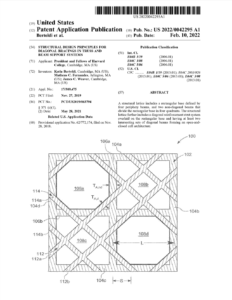
Structural Design Principles for Diagonal Bracings in Truss and Beam Support Systems
Abstract
A structural lattice includes a rectangular base defined by four periphery beams, and two non-diagonal beams that divide the rectangular base in four quadrants. The structural lattice further includes a diagonal reinforcement strut system overlaid on the rectangular base and having at least two intersecting sets of diagonal beams forming an open-and-closed cell architecture.

Soft Robot Gripper with Camera-less Object Classification using Machine Learning
Abstract
Current automation and soft robotic arms use a collection of cameras and sensors to grab and identify inventory objects in manufacturing as well as distribution centers. However, due to sensing limitations, these systems may not be able to classify objects based on features such as compliance, texture and shape. In this project we explore a new and exciting avenue to classify gripped objects via compliance, curvature and pressure data from embedded sensors in combination with machine learning algorithms. We introduce a soft pneumatic actuator that is able to conform to a desired objects shape and size while continuously providing sensor data from multiple force sensors, curvature sensors and fluid pressure sensors. By acquiring data for multiple pre-classified objects, we develop a training database that is used in generative classification machine learning model. Using the model, we are than able to predict the classification new objects. Furthermore, we validate our model by testing a set of objects for which the classes are known and use similar untrained items to understand the limitations of the model and machinery.
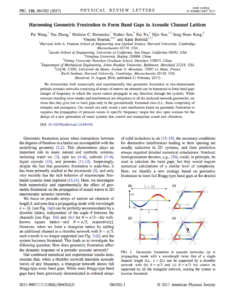
Harnessing Geometric Frustration to Form Band Gaps in Acoustic Networks
doi:10.1103/PhysRevLett.118.084302
Abstract
We demonstrate both numerically and experimentally that geometric frustration in two-dimensional periodic acoustic networks consisting of arrays of narrow air channels can be harnessed to form band gaps (ranges of frequency in which the waves cannot propagate in any direction through the system). While resonant standing wave modes and interferences are ubiquitous in all the analyzed network geometries, we show that they give rise to band gaps only in the geometrically frustrated ones (i.e. those comprising of triangles and pentagons). Our results not only reveal a new mechanism based on geometric frustration to suppress the propagation of pressure waves in specific frequency ranges, but also opens avenues for the design of a new generation of smart systems that control and manipulate sound and vibrations.
Harnessing Design Principles from Glass Sponges for the Production of Structurally Robust Lattices
Abstract
The hexactinellid sponge Euplectella aspergillum (sp.), commonly known as the ”Venus’ flower basket”, has recently attracted increasing attention because of its intricate and regular, cylindrical cage-like structure. This sponge is primarily made of ’brittle silica’ and therefore buckling strength plays crucial role in making it resistant to impacts and environmentally applied stresses. We show through a combination of numerical analysis and experiments that a sponge-inspired double diagonal reinforcement design provides enhanced buckling resistance.
Harnessing Design Principles from Glass Sponges for Structurally Robust Lattices
Abstract
Glass sponges are predominately deep sea sponges that live in ocean depths of 100-2000m. Beyond their fracture propagation inhibiting material composition, these sponges are perceived to exhibit large structural rigidity and strength against buckling. Since these sponges are primarily made of ’brittle silica’, buckling strength may be a crucial property in making them resistant to impact and environmentally applied stresses. Structurally, they exhibit a base square-grid architecture and regular ordering of vertical and horizontal struts that form the skeletal system. Furthermore, their base structure is overlaid with double diagonal reinforcement struts, which create a checkerboard-like pattern of open-closed cell structure. This diagonal reinforcement design is conjectured to give the sponge greater buckling resistance and strength to localized damage then it would experience having a single diagonal reinforcement strut (while allocating the same amount of mass to the diagonal reinforcement.) Analogous to the sponge, many engineering structures, such as buildings and bridges, exhibit diagonal reinforcement struts as a stability mechanism. Based on this similarity, we explore the following research question: Can we generate design principles for diagonal reinforcements of square beam lattices that are optimally designed to avoid global structural buckling? Here, we present a numerical analysis of the structure deformation under various loading conditions as well as survey different arrangements within similar design space of the sponge. Through the various design iterations we look for the critical buckling strain and the elastic load caring capacity. Finally, we compare the results from the sponge design to what is typically used in engineering of structures such as buildings and bridges.
Harnessing Design Principles from Glass Sponges for Engineering Applications
Abstract
Glass sponges are predominately deep sea sponges that live in ocean depths of 100-2000m. Beyond their fracture propagation inhibiting material composition, these sponges are perceived to exhibit large structural rigidity and strength against buckling. Since these sponges are primarily made of ’brittle silica’, buckling strength may be a crucial property in making them resistant to impact and environmentally applied stresses. Structurally, they exhibit a base square-grid architecture and regular ordering of vertical and horizontal struts that form the skeletal system. Furthermore, their base structure is overlaid with double diagonal reinforcement struts, which create a checkerboard-like pattern of open-closed cell structure. This diagonal reinforcement design is conjectured to give the sponge greater buckling resistance and strength to localized damage then it would experience having a single diagonal reinforcement strut (while allocating the same amount of mass to the diagonal reinforcement.) Analogous to the sponge, many engineering structures, such as buildings and bridges, exhibit diagonal reinforcement struts as a stability mechanism. Based on this similarity, we explore the following research question: Can we generate design principles for diagonal reinforcements of square beam lattices that are optimally designed to avoid global structural buckling? Here, we present a numerical analysis of the structure deformation under various loading conditions as well as survey different arrangements within similar design space of the sponge. Through the various design iterations we look for the critical buckling strain and the elastic load carrying capacity. Finally, we compare the results from the sponge design to what is typically used in engineering of structures such as buildings and bridges.
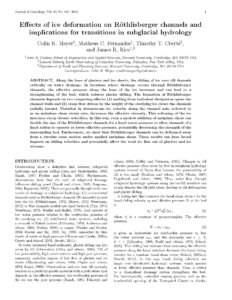
Effects of Ice Deformation on Röthlisberger Channels and Implications for Transitions in Subglacial Hydrology
doi:10.1017/jog.2016.65
Abstract
Along the base of glaciers and ice sheets, the sliding of ice over till depends critically on water drainage. In locations where drainage occurs through Röthlisberger channels, the effective pressure along the base of the ice increases and can lead to a strengthening of the bed, which reduces glacier sliding. The formation of Röthlisberger channels depends on two competing effects: (1) melting from turbulent dissipation opens the channel walls and (2) creep flow driven by the weight of the overlying ice closes the channels radially inward. Variation in downstream ice velocity along the channel axis, referred to as an antiplane shear strain rate, decreases the effective viscosity. This softening of the ice increases creep closure velocities. In this way, even a modest addition of antiplane shear can double the size of the Röthlisberger channels for a fixed water pressure or allow channels of a fixed radius to operate at lower effective pressure, potentially decreasing the strength of the surrounding bed. Furthermore, we show that Röthlisberger channels can be deformed away from a circular cross section under applied antiplane shear. These results can have broad impacts on sliding velocities and potentially affect the total ice flux out of glaciers and ice streams.
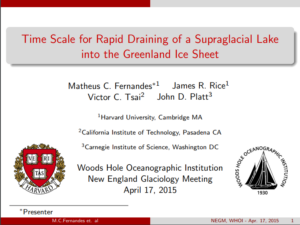
Time Scale for Rapid Drainage of a Surficial Lake into the Greenland Ice Sheet
Abstract
A 2008 report by Das et al. documented the rapid drainage during summer 2006 of a supraglacial lake, of approximately  , into the Greenland ice sheet over a time scale moderately longer than 1 hr. The lake had been instrumented to record the time-dependent fall of water level and the uplift of the ice nearby. Liquid water, denser than ice, was presumed to have descended through the sheet along a crevasse system and spread along the bed as a hydraulic facture. The event led two of the present authors to initiate modeling studies on such natural hydraulic fractures. Building on results of those studies, we attempt to better explain the time evolution of such a drainage event. We find that the estimated time has a strong dependence on how much a pre-existing crack/crevasse system, acting as a feeder channel to the bed, has opened by slow creep prior to the time at which a basal hydraulic fracture nucleates. We quantify the process and identify appropriate parameter ranges, particularly of the average temperature of the ice beneath the lake (important for the slow creep opening of the crevasse). We show that average ice temperatures 5–7
, into the Greenland ice sheet over a time scale moderately longer than 1 hr. The lake had been instrumented to record the time-dependent fall of water level and the uplift of the ice nearby. Liquid water, denser than ice, was presumed to have descended through the sheet along a crevasse system and spread along the bed as a hydraulic facture. The event led two of the present authors to initiate modeling studies on such natural hydraulic fractures. Building on results of those studies, we attempt to better explain the time evolution of such a drainage event. We find that the estimated time has a strong dependence on how much a pre-existing crack/crevasse system, acting as a feeder channel to the bed, has opened by slow creep prior to the time at which a basal hydraulic fracture nucleates. We quantify the process and identify appropriate parameter ranges, particularly of the average temperature of the ice beneath the lake (important for the slow creep opening of the crevasse). We show that average ice temperatures 5–7 below melting allow such rapid drainage on a time scale which agrees well with the 2006 observations.
below melting allow such rapid drainage on a time scale which agrees well with the 2006 observations.
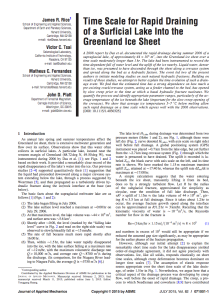
Time Scale for Rapid Drainage of a Surficial Lake into the Greenland Ice Sheet
doi:10.1115/1.4030325
Abstract
A 2008 report by Das et al. documented the rapid drainage during summer 2006 of a supraglacial lake, of approximately  , into the Greenland ice sheet over a time scale moderately longer than 1 hr. The lake had been instrumented to record the time-dependent fall of water level and the uplift of the ice nearby. Liquid water, denser than ice, was presumed to have descended through the sheet along a crevasse system and spread along the bed as a hydraulic facture. The event led two of the present authors to initiate modeling studies on such natural hydraulic fractures. Building on results of those studies, we attempt to better explain the time evolution of such a drainage event. We find that the estimated time has a strong dependence on how much a pre-existing crack/crevasse system, acting as a feeder channel to the bed, has opened by slow creep prior to the time at which a basal hydraulic fracture nucleates. We quantify the process and identify appropriate parameter ranges, particularly of the average temperature of the ice beneath the lake (important for the slow creep opening of the crevasse). We show that average ice temperatures 5–7
, into the Greenland ice sheet over a time scale moderately longer than 1 hr. The lake had been instrumented to record the time-dependent fall of water level and the uplift of the ice nearby. Liquid water, denser than ice, was presumed to have descended through the sheet along a crevasse system and spread along the bed as a hydraulic facture. The event led two of the present authors to initiate modeling studies on such natural hydraulic fractures. Building on results of those studies, we attempt to better explain the time evolution of such a drainage event. We find that the estimated time has a strong dependence on how much a pre-existing crack/crevasse system, acting as a feeder channel to the bed, has opened by slow creep prior to the time at which a basal hydraulic fracture nucleates. We quantify the process and identify appropriate parameter ranges, particularly of the average temperature of the ice beneath the lake (important for the slow creep opening of the crevasse). We show that average ice temperatures 5–7  below melting allow such rapid drainage on a time scale which agrees well with the 2006 observations.
below melting allow such rapid drainage on a time scale which agrees well with the 2006 observations.
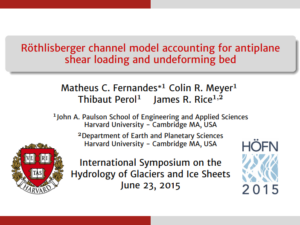
Röthlisberger Channel Model in Ice Stream Shear Margins and Mountain Glaciers Accounting for Anti-plane Shear Loading and Undeforming Bed
Abstract
Ice-stream margins in West Antarctica form from the transition between fast-flowing and stagnant ice. Observations and modelling studies suggest that intense lateral deformation of ice at the margins generates internal meltwater within the ice sheet. Röthlisberger channels (R-channels) may form in which water flows in the downstream direction along the margin. Standard theory argues that the steady-state channel diameter comes from the balance of in-plane creeping and melting rates. However, at the margin, large shear strains acting in the direction parallel to their cross-sectional axis (in the anti-plane direction) can develop. In view of understanding how R-channels evolve within ice streams, we construct a finite-element model (FEM) of an R-channel as considered by Nye (1953) with superimposed anti-plane shear stresses applied along the bed of the ice sheet on the boundary outside of the channel. This is similar to the model presented by Weertman (1972) to describe R-channels formed at the base of mountain glaciers. Weertman’s analysis suggested that the presence of large anti-plane shear stresses, as compared with in-plane stresses, makes the in-plane flow law effectively linear viscous (pseudo-Newtonian). Using our FEM, we examine the limitations of Weertman’s solution as well as when his linear viscous model may be adequate. Furthermore, we examine the effects of shear stresses acting transverse to the channel axis as a result of the interlocking of the bed and the ice. This, as pointed out by Weertman, will change the in-plane solution from being axisymmetric; ultimately making the assumption of a Nye solution near the bed invalid. In addition, we attempt to modify the basal boundary conditions to incorporate the hydrological model proposed by Perol and others (2014), where the basal shear stress varies as a function of the distance from the channel. Ultimately, this makes a comprehensive model for R-channels with anti-plane shear stress hypothesized to exist in ice-stream shear margins and mountain glaciers.

Mechanics of Subglacial Hydrology under Supraglacial Lakes and Ice Stream Shear Margins
Abstract
This thesis is broken down into two parts, both of which are focused on the mechanics of subglacial hydrology. The first part describes the opening behavior of a crack under a supraglacial lake, where a Finite Element Method model is presented to obtain the opening profile of a crack undergoing hydrostatic tension in an infinite power law creep material. The second part focuses on creating a numerical model for the opening diameter of Röthlisberger channels in ice stream shear margins, where antiplane strain rates are superimposed on in-plane stresses.
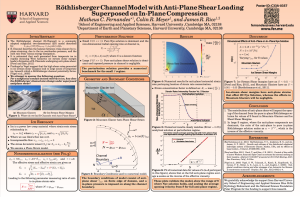
Röthlisberger Channel Model with Anti-Plane Shear Loading Superposed on In-Plane Compression
Abstract
The Röthlisberger channel (R-channel) is a commonly adopted model that balances creep closure by Nye 2D in-plane straining, driven by the ice overburden pressure, against the melt rate from viscous energy dissipation in turbulent flow within the channel. Perol and Rice (AGU abstr. C11B- 0677, 2011; JGR 2014 in review) and Suckale et al. (JGR F003008, 2014) have conjectured that these R-channels may exist at the beds of rapidly straining West Antarctic Ice Stream shear margins. That is expected as a result of melt generation and drainage from forming temperate ice, and the channels may interact through the bed hydrology to partially stabilize the shear margin against lateral expansion. However, at those locations the overburden stresses, driving in-plane flow, are supplemented by substantial anti-plane shear stresses. Similarly, R-channels in mountain glaciers are also subject to both in-plane and anti-plane stresses. These channels usually form in the downstream direction, where anti-plane shear effects arise horizontally from drag at lateral moraines and vertically from the downslope gravity component. Here we examine how superposed anti-plane loading can alter results of the Nye solution for a 2D R channel. We use a combination of perturbation analyses and finite element methods, varying the amount of applied anti-plane stress. A closed-form solution is derived for imposing a small anti-plane perturbation, which has no effect at linear order on the Nye closure rate. Such effects become strong at more substantial perturbations, and the in plane stress and strain fields are then significantly altered from the Nye solution. We further extend our model to compute channel size in terms of the external stressing and flow rate. Understanding the effect of the ice flow on channel size and formation is important to subglacial hydrology, as well as a potentially vital component for our understanding of the formation and motion of ice-streams found in West Antarctica.

Wind Flow Model of Area Surrounding the Case Western Reserve University Wind Turbine
Abstract
The CWRU Turbine is a research turbine located in a urban campus in Cleveland, Ohio. This location may create turbulence, resulting in a possible loss in energy generation. This research attempts to answers the question of whether the wind flow is affected by the buildings or not. The surrounding buildings, which vary in height from 20 to 40 meters, may affect the wind patterns at the hub height. In order to investigate this issue, a CFD model of the immediate area was generated. The analysis using a CFD model includes prevailing wind directions and analyzes the outcomes of the wind flow pattern around the turbine. Reasonable agreement was found when the model was tested and compared against real wind measurements.
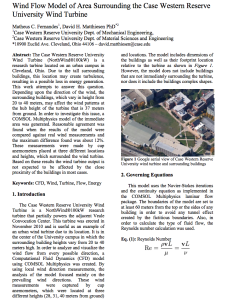
Wind Flow Model of Area Surrounding the Case Western Reserve University Wind Turbine
Abstract
The CWRU Turbine is a research turbine located in a urban campus in Cleveland, Ohio. This location may create turbulence, resulting in a possible loss in energy generation. This research attempts to answers the question of whether the wind flow is affected by the buildings or not. The surrounding buildings, which vary in height from 20 to 40 meters, may affect the wind patterns at the hub height. In order to investigate this issue, a CFD model of the immediate area was generated. The analysis using a CFD model includes prevailing wind directions and analyzes the outcomes of the wind flow pattern around the turbine. Reasonable agreement was found when the model was tested and compared against real wind measurements.
Design and Implementation of Wind Turbine Torque Measurement Device
Abstract
With the pursuit of understanding the torque on the shaft applied by the wind force on the blades, a torque measuring device was implemented to the turbine. This device is composed of two perpendicular strain gauges that measure continuous strain on the shaft. The orientation of the strain gauges gives measurement data on the torque as well as the RPM of the shaft. From these measurements we found a reverse torque phenomenon on the shaft when an emergency stop (e-stop) or the generator switches from low generation to high generation. This project uses wind data, and torque measurements data to analyze the effects created by the reverse torques on the shaft. This is a preliminary analysis to validate the need for a torque limiting device to be installed on the shaft. The device was designed to attach directly to the shaft as well as to withstand the brutal weather conditions that may occur in the nacelle.
